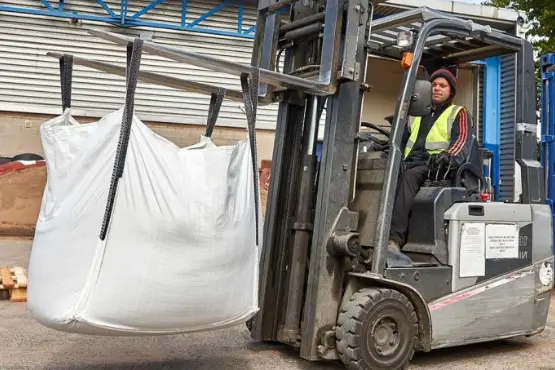This article provides a comprehensive guide to understanding one ton bulk bags, also known as tonne bags, focusing on size and capacity considerations. We’ll delve into the crucial aspects of selecting the right polypropylene bag for your specific needs, whether it’s for cement, rubble, or other heavy materials. If you’re in the market for durable, reliable, and cost-effective bulk packaging solutions, this article is worth reading because it will equip you with the knowledge to make informed decisions, avoid costly mistakes, and optimize your bulk material handling process. As Allen, from China, a representative of a B2B big bag factory with 7 production lines, I’ll share insights gained from years of experience exporting to the USA, North America, Europe, and Australia.
1. What Exactly is a One Ton Bulk Bag?
A one ton bulk bag, sometimes referred to as a tonne bag, is a large, industrial container made from woven polypropylene fabric. These bags are specifically designed for the storage and transport and storage of dry, flowable materials. The term "one ton" refers to the bag’s typical safe working load (SWL), meaning it can safely hold up to 1000 kilograms (or approximately 2200 pounds) of material. However, it’s crucial to understand that the actual carrying capacity can vary based on the material’s density and the bag dimensions.
These bags are used across various industries, including agriculture, mining, chemicals, and construction. For example, a mining company like Mark Thompson’s in the USA might use bulk bags to transport minerals, while an agricultural company might use them for seeds or fertilizers. These are also often referred to as FIBCs (Flexible Intermediate Bulk Containers). These polypropylene bags are a cost-effective and efficient solution for handling building materials and other bulk goods.
2. Why Are Size and Capacity So Important?
Choosing the correct size and capacity for your bulk bag is paramount for several reasons:
- Safety: Overfilling a bag beyond its safe working load (SWL) can lead to bag failure, causing spills, injuries, and property damage.
- Efficiency: Using a bag that’s too small will require more bags, increasing handling time and labor costs. A bag that’s too large may not fit properly in your storage or transport equipment.
- Cost-Effectiveness: Selecting the right size optimizes material usage and minimizes waste. It also ensures you’re not paying for unnecessary bag capacity.
- Regulations: Certain industries and regions have specific regulations regarding the size and weight of bulk bags used for transport.
Imagine Mark Thompson’s company receiving a shipment of bulk bags that are too small for their machinery. This would lead to significant delays and operational headaches. Choosing the right size is crucial for seamless operations.
3. How to Determine the Right Bulk Bag Dimensions for Your Needs?
Determining the ideal bag dimensions involves considering several factors:
- Material Density: The density of the material you’ll be storing is the most critical factor. Denser materials will take up less space than lighter materials. For example, a tonne bag filled with sand will be smaller than the same tonne bag filled with wood chips.
- Volume Calculation: Calculate the volume of material you need to store. This is usually expressed in cubic meters (m³) or cubic feet (ft³).
- Equipment Compatibility: Ensure the bag dimensions are compatible with your filling, discharging, and handling equipment (e.g., forklifts, cranes).
- Storage Space: Consider the available storage space and how the filled bags will be stacked.
A simple formula to guide you:
- Required Volume = (Total Weight of Material) / (Material Density)
Once you know the required volume, you can consult with a bulk bag supplier to find a bag with suitable internal dimensions.
4. What are the Standard Sizes and Capacities of Bulk Bags?
While bulk bags can be customized to almost any size, some standard dimensions are commonly used. Here’s a table illustrating some typical sizes and their approximate capacities:
| External Dimensions (cm) | Internal Dimensions (cm) | Approximate Volume (m³) | Typical Use |
|---|---|---|---|
| 90x90x90 | 86x86x86 | 0.75 | General Purpose, Rubble |
| 90x90x120 | 86x86x116 | 1.0 | Cement, Fertilizer |
| 100x100x150 | 96x96x146 | 1.5 | Minerals, Grains |
| 65x65x65cm | 61x61x61 | 0.5 | 500kg items |
| 90x90x100 | 86x86x96 | 0.73 | General, Rubble |
Note: These are approximations, and actual capacity will vary based on the material’s density and the bag’s construction. A bag with dimensions 90x90x90cm meaning a volume capacity of approximately 0.75 cubic meters.
The 90x90x90 bag is a common size, often used as a builders bag or waste bag. It’s a robust bag, often available from stock.
5. Understanding Bulk Bag Loops and Lifting Options: Cross Corner vs. Standard?
The loop configuration is another crucial aspect of bulk bag design. The loops are how the bag is lifted and moved, typically by a forklift.
- Standard Loops: These are typically four separate loops sewn into the corners of the bag. They are suitable for most general applications. Four standard loops for easy handling.
- Cross Corner Loops: These loops are sewn down the sides of the bag and extend across the corners. This design provides greater stability and is often preferred for heavier loads or when using lifting equipment with wider forks.

The choice between standard and cross corner loops depends on your specific handling requirements. For example, if Mark Thompson’s team frequently uses forklifts with specific fork spacing, they might prefer cross corner loops for better stability. Standard loops for easy handling are suitable for many situations.
6. What Role Do Liners Play in Bulk Bag Applications?
Liners are often used inside bulk bags to provide an additional layer of protection for the contained material. They are particularly important for:
- Fine Powders: Liners prevent the leakage of fine materials like flour or chemical powders.
- Moisture-Sensitive Materials: Liners protect materials like seeds or food products from moisture damage.
- Food-Grade Applications: Food-grade liners ensure that the material doesn’t come into contact with the bulk bag itself, maintaining hygiene and preventing contamination.
- Dangerous good: Like the PP Woven Container For Dangerous Goods Type C Jumbo anti Static Bulk Bag.
Liners can be made from various materials, including polyethylene (PE) and aluminum. PP Woven PE Bulk Container Liners are a great option for many situations. For added bulk bag capacity, you can consider Baffle Bulk Form Fit PE big bag liner.
7. How Does Material (Polypropylene) Impact Bulk Bag Performance?
Polypropylene is the primary material used in bulk bag construction due to its excellent properties:
- Strength and Durability: Polypropylene is a strong and durable thermoplastic polymer, making it resistant to tearing and puncturing. This is essential for heavy-duty applications.
- Lightweight: Despite its strength, polypropylene is relatively lightweight, minimizing the overall weight of the filled bag.
- Chemical Resistance: Polypropylene is resistant to many chemicals, making it suitable for a wide range of applications.
- UV Resistance: UV stabilized polypropylene is often used to protect the bag and its contents from degradation due to sunlight exposure.
The quality of the woven polypropylene fabric is crucial. Higher quality fabric will have a higher tensile strength and better overall performance.
8. What Certifications and Safety Standards Should You Look For?
When purchasing bulk bags, especially from international suppliers, it’s crucial to ensure they meet relevant safety standards and certifications. Some key certifications to look for include:
- ISO 9001: This certification demonstrates that the supplier has a quality management system in place.
- ISO 21898: This is a specific standard for non-dangerous goods FIBCs (Flexible Intermediate Bulk Containers).
- UN Certification: For bulk bags used to transport hazardous materials, UN certification is mandatory.
- Safe Working load: Make sure your bulk bag can hold a 1000kgs of load.
These certifications provide assurance that the bags have been tested and meet specific quality and safety requirements. Mark Thompson, as a procurement officer, would always prioritize suppliers with these certifications to ensure the safety and reliability of the big bags he purchases.
9. How to Choose the Right Bulk Bag Supplier (Especially from China)?
Choosing the right supplier is just as important as choosing the right bulk bag. Here are some key considerations, particularly when sourcing from China:
- Experience and Reputation: Look for a supplier with a proven track record of exporting to your region. Check online reviews and ask for references.
- Production Capacity: Ensure the supplier has the capacity to meet your volume requirements and lead time expectations. A factory with multiple production lines (like ours with 7) is often a good indicator.
- Quality Control: Inquire about the supplier’s quality control procedures. Do they have in-house testing facilities? Do they conduct regular inspections?
- Communication: Effective communication is crucial. Choose a supplier with responsive and knowledgeable sales representatives who can answer your questions clearly and promptly.
- Price: price always an inportant factor.
10. Addressing Common Pain Points: Communication, Delays, and Certification.
Based on my experience, and mirroring the concerns of customers like Mark Thompson, I’ve identified three major pain points when sourcing bulk bags from international suppliers:
- Inefficient Communication: Language barriers and time zone differences can sometimes lead to miscommunication. Solution: Insist on clear and prompt communication, utilizing email, video calls, and detailed specifications.
- Shipment Delays: Delays can disrupt production schedules and lead to financial losses. Solution: Choose a supplier with a reliable logistics network and a track record of on-time delivery. Get clear timelines and regular updates.
- Certificate Fraud: Some suppliers may provide fraudulent certificates. Solution: Verify certificates with the issuing body and work with reputable suppliers who have a history of compliance.

As Allen, I understand these concerns. We strive to address them by providing excellent customer service, transparent communication, and verifiable certifications.
Summary of Important Things to Remember
- Size and capacity are crucial for safety, efficiency, and cost-effectiveness.
- Material density is the primary factor in determining the correct bag dimensions.
- Consider loop configuration (standard vs. cross corner) based on your handling equipment.
- Liners provide added protection for specific materials and applications.
- Polypropylene is the ideal material for bulk bags due to its strength, durability, and chemical resistance.
- Look for relevant certifications (ISO 9001, ISO 21898) to ensure quality and safety.
- Choose a reputable supplier with a proven track record, strong communication, and reliable logistics.
- Address pain points like communication, delays, and certification proactively.
- The bulk bag is the perfect bag that you can use for transport and storage of construction materials.
- A waste bag can be used for all kind of big debris.
By carefully considering these factors, you can select the right heavy-duty one ton bulk bag for your needs, ensuring a smooth and efficient bulk material handling process. This information is crucial for anyone looking to buy bulk bags, whether they are for top soil, aggregate, or other materials. Remember that emptying spout and discharge spout features can make bag handling made easy. A high-quality bulk bag is a valuable investment for any business dealing with large quantities of materials.
Post time: Mar-12-2025


